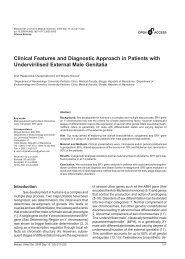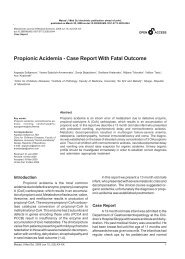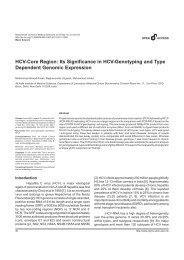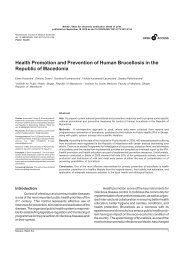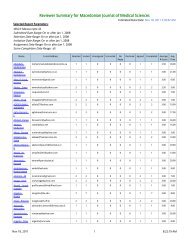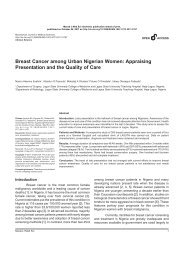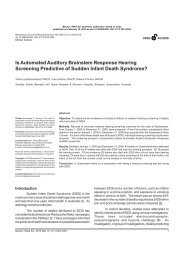Tinea Faciei - Macedonian Journal of Medical Sciences
Tinea Faciei - Macedonian Journal of Medical Sciences
Tinea Faciei - Macedonian Journal of Medical Sciences
Create successful ePaper yourself
Turn your PDF publications into a flip-book with our unique Google optimized e-Paper software.
Clinical ScienceTable 1: Distribution <strong>of</strong> patients with dermatophytosis byisolated dermatophytes at the Department <strong>of</strong> Dermatologyin Skopje in the years from 2007 to 2009.Figure 1: <strong>Tinea</strong> faciei.Jan 2009 were evaluated. The diagnosis was confirmed bymicroscopic examination <strong>of</strong> skin and hair specimens andby culture on Sabouraud’s medium with addedchloramphenicol, gentamycin and actidion.ResultsSix hundreds patients with dermatophytosis werediagnosed over a time period <strong>of</strong> twenty months (Jun 2007– January 2009). The tinea faciei patients represented2.2% (13) <strong>of</strong> all patients with dermatophytosis (Fig. 2).may occur in all age groups, but two peaks are observed.One peak involves children between 3 and 10 years andthe second one between 51 and 70 years.The topical treatment for <strong>Tinea</strong> faciei patients isshown in Table 2. We can see that in 70% <strong>of</strong> the patientsthe topical corticosteroid treatment was the first choise.Anamnesticaly, average time to confirm the diagnosis for<strong>Tinea</strong> faciei was 55 days.Table 2: Topical treatment in patients with <strong>Tinea</strong> faciei.Figure 2: Distribution <strong>of</strong> patients with dermatophytosis at theDepartment <strong>of</strong> Dermatology in Skopje in the years from 2007 to 2009.Most frequently isolated dermatophytic speciesare Trichophyton verrucosum (38.46% <strong>of</strong> all <strong>Tinea</strong> faciepatients), Microsporum canis (30.77%), Trichophytonrubrum (23.08%) and Trichophyton mentagrophytes(7.69%) (Table 1). In all age groups <strong>Tinea</strong> faciei was morefrequent in males. According to patient’s age <strong>Tinea</strong> faciei28Discussion<strong>Tinea</strong> faciei is a uncommon superficialdermatophyte infection limited to the glabrous skin <strong>of</strong> theface. In pediatric and female patients, the infection mayappear on any surface <strong>of</strong> the face, including the upper lipand chin. In men, the condition is known as <strong>Tinea</strong> barbaewhen a dermatophyte infection <strong>of</strong> bearded and moustachearea occurs. The <strong>Tinea</strong> faciei patients represented 2.2%<strong>of</strong> all patients with dermatophytosis. There is decrease <strong>of</strong>incidence <strong>of</strong> the <strong>Tinea</strong> faciei patients treated in theMycological Ambulance, Department <strong>of</strong> Dermatology,http://www.mjms.ukim.edu.mk
Starova et al. <strong>Tinea</strong> <strong>Faciei</strong> – Hypo Diagnosed Facial Dermatoses<strong>Medical</strong> Faculty in Skopje. The infection is frequentlyacquired from pets, but it can also be spread fromindividuals with dermatophyte infection elsewhere on thebody. The causative agent <strong>of</strong> <strong>Tinea</strong> faciei varies accordingto trhe geographic region and the potential reservoirslocated in the environment [1-3].Generally, animal reservoirs <strong>of</strong> zoophilicdermatophytes, especially Microsporum canis andTrichophyton verrucosum, are global among pets andlivestock [4]. The dermatophytes isolated in our patientsare: Trichophyton verrucosum in 5 cases (38% <strong>of</strong> <strong>Tinea</strong>faciei patients), Microsporum canis 4 cases (31%),Trichophyton rubrum 3 cases (23%) and Trichophytonmentagrophytes var. mentagrophytes 1 case (8%). As inmany regions in the world [4], in our country predominatezoophilic dermatophytes. Infection caused by zoophilicdermatophytes is usually associated with inflammatoryreactions that are more severe than those due to antropohilicfungi. Deep inflammatory plaques are round, inflamed andcan have a boogy pustular surface. Consistent andintegrated efforts <strong>of</strong> medical and veterinary servicesassociated with health education are required in future toeliminate further spread <strong>of</strong> infection. On the other hand, inNorth America, Trichophyton tonsurans, Trichophytonrubrum and Microsporum canis are the most commondermatophytes in <strong>Tinea</strong> faciei patients [1-3]. The infectioncaused by antopophilic fungi can be spread from personto-personwith dermatophyte infection elsewhere on thebody. Occasionally, <strong>Tinea</strong> faciei may simultaneouslyoccur with other forms <strong>of</strong> dermatophyte infections,especially <strong>Tinea</strong> capitis and <strong>Tinea</strong> corporis [5]. One studyshowed that, in 85% <strong>of</strong> <strong>Tinea</strong> faciei patients, the nails werealso infected by the same agent isolated from the face[1,6].In our patients <strong>Tinea</strong> faciei was more frequent inmales. It has been suggested that females are morefrequently affected than males [1]. The difference may besemantic, as dermatophyte infection on the beardedareas <strong>of</strong> males are <strong>of</strong>ten diagnosed as <strong>Tinea</strong> barbae,whereas, in females, they are more likely to be diagnosedas <strong>Tinea</strong> faciei [6]. <strong>Tinea</strong> faciei may occur in all age groups,but two peaks are observed. One peak involves children,<strong>of</strong>ten due to direct contact with pets [1]. Children are <strong>of</strong>teninfected on following holidays when they may come intocontact with animals whilst playing [1]. Cases have alsobeen reported in neonates, but are rare [7-9]. Thesepatients may acquire the infection from parents or siblings.The second peak in our patients occurred in elder populationbetween 51 and 70 years, which can be explained as aresult <strong>of</strong> higher risk in elderly for dermatophytsosis.HoweverMaced J Med Sci. 2010 Mar 15; 3(1):27-31.<strong>Tinea</strong> faciei may occur in those aged 20 – 40 years. Thismay be due to the heightened physical activity commonin this age group [10,11]. Mycological investigation isessential in the diagnosis <strong>of</strong> <strong>Tinea</strong> faciei. It includes directmicroscopic examination for hyphal elements and culturing.Microscopic examination <strong>of</strong> potassium hydroxide (KOH)preparations is the easiest, fastest and most sensitivetest. Most cases <strong>of</strong> <strong>Tinea</strong> faciei are superficial and curablewith topical antifungals. However, resistant strains,extensive disease, incognito presentation orimunosupression may require oral antifungal therapy [12].Because <strong>of</strong> the complex anatomy <strong>of</strong> the face, atypicalfeatures are more frequently found on the glabrous skinthan the typical annular patches <strong>of</strong> <strong>Tinea</strong> corporis (Fig. 3).Figure 3: <strong>Tinea</strong> faciei.The variable morphology <strong>of</strong> <strong>Tinea</strong> faciei creates alarge differential diagnosis. The differential includes manynon-fungal dermatoses such as rosacea (Fig. 4), atopicFigure 4: Rosacea-like <strong>Tinea</strong> faciei.29
Clinical Sciencedermatitis, pityriasis alba, seborrheic dermatitis, psoriasisvulagris, irritant contact dermatitis, perioral dermatitis,discoid lupus erythematosus (DLE), systemic lupuserythematosus SLE, granuloma annulare (Fig. 5),polymorphous light eruption (PMLE), impetigo contagiosaetc.PMID:15186226.2. Alteras I, Sandbank M, David M, Segal R. 15-year survey <strong>of</strong>tinea faciei in the adult. Dermatologica. 1988;177(2):65-9.doi:10.1159/000248519 PMID:2971583.3. Kemna ME, Elewski BE. A U.S. epidemiologic survey <strong>of</strong>superficial fungal diseases. J Am Acad Dermatol.1996;35(4):539-42. doi:10.1016/S0190-9622(96)90675-1PMID:8859279.4. Jorquera E, Moreno JC, Camacho F. [<strong>Tinea</strong> faciei:epidemiology]. Ann Dermatol Venereol. 1992;119(2):101-4.PMID:1605504.5. Cabon N, Moulinier C, Taieb A, Maleville J. <strong>Tinea</strong> capitisand faciei caused by Microsporon langeronii in twoneonates. Pediatr Dermatol. 1994;11(3):281. doi:10.1111/j.1525-1470.1994.tb00607.x PMID:7971570.6.Alteras I, Sandbank M, David M, Segal R. 15-year survey <strong>of</strong>tinea faciei in the adult. Dermatologica. 1988;177(2):65-9.doi:10.1159/000248519 PMID:2971583.7. Bardazzi F, Raone B, Neri I, Patrizi A. <strong>Tinea</strong> faciei in anewborn: a new case. Pediatr Dermatol. 2000;17(6):494-5.doi:10.1046/j.1525-1470.2000.01837-6.x PMID:11123794.30Figure 5: Granuloma annulare-like <strong>Tinea</strong> faciei.<strong>Tinea</strong> faciei is the most frequently misdiagnosedentity amongst cutaneous fungal infections due its variableappearance [1,13]. As many as 70% <strong>of</strong> patients with <strong>Tinea</strong>faciei are initially misdiagnosed as having other dermatoses[1,14]. In two independent studies found that 50% <strong>of</strong>patients with <strong>Tinea</strong> faciei were misdiagnosed as having aphotosensitive skin disease [15,16]. In our patients,according to the first-line topical treatment, we can concludethat, paradoxial, in, none <strong>of</strong> the cases it’s not even thoughtthat the diagnosis could be <strong>Tinea</strong> faciei. Average time tomycologicaly confirm diagnosis <strong>of</strong> <strong>Tinea</strong> faciei in ourpatients was 55 days!In patients with erythematous lesions <strong>of</strong> the face,a diagnosis <strong>of</strong> <strong>Tinea</strong> faciei should be considered. Thevariable morphology <strong>of</strong> <strong>Tinea</strong> faciei creates a large differentialdiagnosis. The frequent atypical clinical features andincognito presentations make <strong>Tinea</strong> faciei a unique andmost frequently hypo diagnosed facial dermatoses with<strong>of</strong>ten delayed appropriate treatment.References1. Lin RL, Szepietowski JC, Schwartz RA. <strong>Tinea</strong> faciei, an<strong>of</strong>ten deceptive facial eruption. Int J Dermatol.2004;43(6):437-40. doi:10.1111/j.1365-4632.2004.02339.x8. Cohen-Abbo A. Newborn with vesicular rash. <strong>Tinea</strong>corporis (tinea faciei). Pediatr Infect Dis J. 2000;19(7):661,676-7.doi:10.1097/00006454-200007000-00018PMID:10917228.9. Kanwar AJ, Sharma R, Das Mehta S, Kaur S. <strong>Tinea</strong> facieiin a 2-day-old infant. Pediatr Dermatol. 1990;7(1):82.doi:10.1111/j.1525-1470.1990.tb01083.x PMID:2343013.10. Adams BB. <strong>Tinea</strong> corporis gladiatorum. J Am AcadDermatol. 2002;47(2):286-90. doi:10.1067/mjd.2002.120603 PMID:12140477.11. Allen AM. Epidemic Trichophyton mentagrophytesinfections in servicemen. Source <strong>of</strong> infection, role <strong>of</strong>environment, host factors, and susceptibility. JAMA.1973;226(8):864-7. doi:10.1001/jama.226.8.864PMID:4800333.12. Piérard GE, Arrese JE, Piérard-Franchimont C. Treatmentand prophylaxis <strong>of</strong> tinea infections. Drugs. 1996;52(2):209-24. doi:10.2165/00003495-199652020-00005PMID:8841739.13. Szepietowski JC. Terbinafine exacerbates psoriasis:case report with a literature review. Acta DermatovenerolCroat. 2003;11(1):17-21. PMID:12718791.14. Drake LA, Dinehart SM, Farmer ER, Goltz RW, GrahamGF, Hardinsky MK, Lewis CW, Pariser DM, Skouge JW,Webster SB, Whitaker DC, Butler B, Lowery BJ, Elewski BE,Elgart ML, Jacobs PH, Lesher JL Jr, Scher RK. Guidelines<strong>of</strong> care for superficial mycotic infections <strong>of</strong> the skin: tineacorporis, tinea cruris, tinea faciei, tinea manuum, and tineahttp://www.mjms.ukim.edu.mk
Starova et al. <strong>Tinea</strong> <strong>Faciei</strong> – Hypo Diagnosed Facial Dermatosespedis. Guidelines/Outcomes Committee. AmericanAcademy <strong>of</strong> Dermatology. J Am Acad Dermatol. 1996;34(2Pt 1):282-6. doi:10.1016/S0190-9622(96)80135-6PMID:8642094.15. Patel G, Mills C. <strong>Tinea</strong> faciei due to Microsporum canisabscess formation. Clin Exp Dermatol. 2000;25(8):608-10.doi:10.1046/j.1365-2230.2000.00718.x PMID:11167972.16. Shapiro L, Cohen HJ. <strong>Tinea</strong> faciei simulating otherdermatoses. JAMA. 1971;215(13):2106-7. doi:10.1001/jama.215.13.2106 PMID:5108222.Maced J Med Sci. 2010 Mar 15; 3(1):27-31.31



